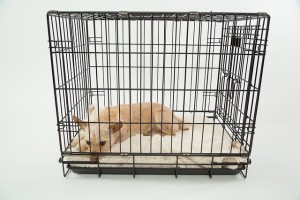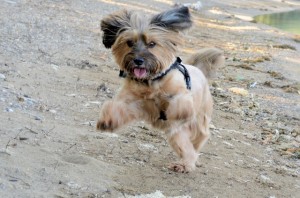Below is a comprehensive list of online resources about the most common dog behavior issues, assembled here in this convenient format for folks to use and share. Early intervention is the best way to prevent behaviors from getting out of control, and for helping keep pets, healthy, happy and in their homes and out of the local shelter system.
General Training
House Training
Dogs do not pee and poop in the house because they are mad at you. If your dog is eliminating in the house he might need a housetraining refresher course.
house he might need a housetraining refresher course.
For the basic routine, including a good short video, see the Open Paw website: Housetraining
There are several different reasons dogs might go to the bathroom in the house. The San Francisco SPCA has handouts that can help you identify why your dog is eliminating inside, and what to do about it: House Soiling | House Training Your Adult Dog | Marking | Submissive and Excitement-Urination (PDF)
The Center for Shelter Dogs offers this helpful information about house training adopted shelter animals House Training Made Easy (PDF)
Dogs that have been learned to soil their living areas can be especially challenging house train. This is particularly common with dogs that have come from puppy mills. Although the basics are the same as with any dog, the ASPCA give some excellent tips for meeting the specific challenges of house training a puppy mill dog: House Training Your Puppy Mill Dog
And for a good video reminder of all the basics:[wpdevart_youtube]QvPiFcG7ROI[/wpdevart_youtube]
[tabby title="Crate Training"]
CRATE TRAINING
The single best way to eliminate housetraining accidents, destructive chewing, and inappropriate behavior toward visitors is teach your dog to love her crate, and then to use occasional crating to prevent problem behaviors.
problem behaviors.
The ASPCA’s step-by-step program teaches your dog to love her crate in 72 hours: Weekend Crate Training
The San Francisco SPCA provides a nice, concise handout to remind you of the steps and progression for crate training: Crate Training Your Adult Dog
Open Paw has a handout including nice video examples of both crate training and how to create a longer term confinement area for puppies: Pet Basics: Confinement
In some cases it may be helpful also to teach your dog to be relaxed on an inside tether or “tie down”. We recommend that tie downs be used only under direct supervision, and that you use a crate or other confinement area when you cannot be directly supervising your dog. We also recommend attaching a tie down to a body harness rather than even a flat collar to reduce any chance of injury. NEVER use a tie down with any kind of correction collar (choke chain, pinch or prong collar) or head collar. There is a link to a handout on Tie Down Basics at the bottom of the Badrap Blog text: In Praise of Tie-Downs
This video is on the basic steps of training your dog to go in his crate:[wpdevart_youtube]dUzF0g0PwY4[/wpdevart_youtube] [tabby title="Coming When Called"]
NOT COMING WHEN CALLED
Does your dog not come when called? This is not only very frustrating, it can also be a major safety issue for your dog. Fortunately, all dogs can learn to come when called through a combination of management and positive reinforcement.
issue for your dog. Fortunately, all dogs can learn to come when called through a combination of management and positive reinforcement.
The San Francisco SPCA outlines the basic rules and several fun exercises to teach your dog to come when called: Recall Commands (PDF)
So does Open Paw, including a short video of the attention exercise that is essential to building a reliable recall: The Recall: Teaching Your Dog to Come Reliably When Called
Your Dog’s Friend provides a bit more detail: Coming When Called
A short video demonstration:[wpdevart_youtube]PL9Rk-8KF9I[/wpdevart_youtube] [tabby title="New Baby"]
BRINGING HOME BABY
If you have a new baby in the house and your dog has never been around babies you might be concerned, but many dogs can acclimate to infants. Of course, if you are able to do some preparation with your dog before the baby arrives, you will have even more likelihood of success.
The San Francisco SPCA outlines training suggestions for the stages of pregnancy and baby’s arrival:Dog, Will Baby Make Four (PDF)
North Carolina trainer Jennifer Shryock developed a comprehensive program to increase the success of dogs in homes with children: familypaws.com
Dr. Sophia Yin also provides tips for keeping your dog and baby safe: Dogs and Babies: Can They be Safe in the Same Household?
[tabbyending]Basic Behavior
Jumping Up On People
Does your dog jump up on you or visitors to your house? Jumping up to greet is a normal behavior that responds well to consistent training, especially if you focus on teaching your dog what you would like him/her to do instead of jumping up.
For straightforward steps to teach your dog not to jump up in a variety of situations, see the San Francisco SPCA’s handout: Dog Behavior: Jumping (PDF)
For more detailed training suggestions, the ASPCA’s virtual behaviorist is a great resource: Teaching Your Dog Not to Jump Up on People
Open Paw’s basic philosophy is the most effective, simplest solution is to teach the dog the right way to greet people: Jumping up: How to teach your dog a polite greeting
The Center for Shelter Dogs offers this perspective on dealing with high energy dogs who jump: Highly Exuberant Dogs (PDF)
This video shows the training in action. The dog in this video is a puppy, but the principles are the same for dogs of any age!
[wpdevart_youtube]lC_OKgQFgzw[/wpdevart_youtube] [tabby title="Pulling Leash"]Pulling On Leash
Many behavior problems can result from dogs being bored and under-exercised. Walking your dog is good for both of you! Advances in humane walking equipment and some basic tips and techniques can make leash walks possible for almost every dog.Lay down in your way catnip stuck in a tree, sunbathe kittens.
The ASPCA provides a great overview of the different types of equipment available, pros and cons of each, as well as training tips for teaching your dog to walk nicely on leash: Walking Equipment for Your Dog
Dr. Sophia Yin gives even more detailed training instructions for polite leash walking (with pictures!): Choose the Right Walking Pace and Make It Clear Pulling Doesn’t Work
Your Dog’s Friend also has good basic pointers: Pulling On Leash
The following tips from the San Diego Humane Society can help you enjoy daily strolls with your beloved pooch right by your side: Does Your Dog Take YOU for a Walk (PDF)
A video showing some of these techniques in action is at:[wpdevart_youtube]ueE1S1k74Ao[/wpdevart_youtube] [tabby title="Chewing"]
Chewing
Chewing is normal behavior for all dogs, but you can teach your dog what to chew and what not to chew. Chewing is also a stress reliever for dogs, so sometimes excessive chewing can indicate a more severe underlying problem.
The ASPCA gives excellent tips for preventing destructive chewing as well as some signs to look out for that might indicate the chewing is a symptom of some other issue for your dog: Destructive Chewing
Another good article is at Your Dog’s Friend, which also gives links to trainer-tested and approved chew toys that can help your dog build the habit of acceptable chewing instead of destructive chewing: Oh, dear. He’s done it again
Dog Star Daily provides great help for destructive chewing and many other dog behavior issues. You do have to create an account to access the information, but it’s free and easy to do. Dog Star Daily Training: Destructive Chewing
There is also a good summary plus a video example from Open Paw: Inappropriate Chewing and Household Destruction
The Center for Shelter Dogs offers this helpful printout: Destructive Behavior (PDF)
Additional useful information from The San Francisco SPCA: Chewing (PDF)
To stop destructive chewing as well as many other unwanted behaviors without creating fear or aggression, it can be helpful to teach your dog
[wpdevart_youtube]TBvPaqMZyo8[/wpdevart_youtube] [tabby title="Barking"]Barking
Barking is also normal dog behavior, but it may be problematic for people. It is very important to understand the cause of your dog’s barking to determine what the most effective intervention will be.
The San Francisco SPCA provides a good summary of the different types of barking and management and training tips: Barking (PDF)
Your Dog’s Friend gives good practical training tips for the different kids of barking as well as links to many other helpful resources: Barking
The ASPCA provides more detailed training instructions for some anti-barking exercises: Barking
There is also a good summary from Open Paw: Quieting a Barking Dog
Emily Larlham (Kikopup) has an excellent series of videos that demonstrate training your dog not to bark in a variety of situations:[wpdevart_youtube]bpzvqN9JNUA[/wpdevart_youtube]
[tabby title="Digging"]
Digging
Digging is another normal dog behavior that may have several different motivations. Effective training requires correctly assessing the reason behind your dog’s digging.
The San Diego Humane Society provides a great summary of the different motivations for digging and training recommendations for each: How To Solve the Digging Problems (PDF)
Sometimes the best solution for digging is just to give your dog a place where it’s allowed and teach her only to dig there. The ASPCA gives directions for creating a digging pit for your dog: How to Create a Digging Pit for Your Dog
There is also a good summary from Open Paw: Digging
[tabby title="Escaping"]Escaping From Yard
Escaping from your house or yard can be a life-threatening behavior issue for your dog. A combination of management and training can be successful in keeping many dogs safely contained.
San Diego Humane Society giveS good summaries of the different reasons dogs might escape their yards, and management and training tips for each: The Canine Escape Artist (PDF)
ASPCA also has good summaries of reasons dogs might escape, and management and training tips for each: Dog Behavior: Escaping the Yard
Best Friends Animal Society also gives a good tip for a training exercise to prevent door-dashing: Escaping
The Center for Shelter Dogs offers this helpful printout: Escape Behavior
[tabbyending]Anxiety (fear of …)
Fearful of People
Dogs that are afraid of people can have trouble doing many things, since people are always around. Fear or people can also lead to aggression if your dog feels like he is trapped and doesn’t have any option to get away from the person who is scaring him. Managing your dog’s encounters to prevent this as well as teaching her to be more comfortable can significantly improve both of your quality of life.
Recognizing the body language of fear in dogs is an essential first step. Study this Free Poster from Dr. Sophia Yin: Body Language of Fear in Dogs
The Center for Shelter Dogs has good tips for introducing your fearful dog to new people: Fear of People (PDF)
The San Francisco SPCA offers this good short handout with tips for training and helping your fearful dog: Fearful Behavior (PDF)
The ASPCA gives more detailed instructions for training exercises: Fear of People
Extensive resources for helping your fearful dog can be found at: fearful dogs.com
This helpful video discusses how to train your dog not to be fearful of everyday objects or strangers: Barking Episode 4- Barking at Strangers
[wpdevart_youtube]LXCELHDT2fs[/wpdevart_youtube][tabby title="New Things"]
FEARFUL OF NEW ENVIRONMENTS
Some dogs have more generalized fear of anything that is new. These dogs are often afraid of new people too, but there are some additional tips that will help if your dog is afraid of new places or experiences.
The ASPCA has an excellent article that includes different training exercises for dogs with mild, moderate, or severe separation anxiety: Neophobia (Fear of New Things)
Your Dog’s Friend gives another version of the exercises for mild to moderate separation anxiety: How to Recognize Your Dog’s Stress Signals
Recognizing the body language of fear in dogs is an essential first step. Study this Free Poster from Dr. Sophia Yin: Body Language of Fear in Dogs
Video demonstrations of exercises to reduce fear and increase confidence:
[wpdevart_youtube]3-CCJxF-9U4[/wpdevart_youtube]
[tabby title="Separation"]
ANXIOUS WHEN LEFT ALONE
Dogs are social animals, so many dogs experience some level of anxiety when they are left alone. This can range from mild distress to true separation anxiety. This can be a very frustrating problem to deal with, but consistent, systematic training can make a significant improvement for many dogs.
The ASPCA has an excellent article that includes different training exercises for dogs with mild, moderate, or severe separation anxiety: Separation Anxiety
Your Dog’s Friend gives another version of the exercises for mild to moderate separation anxiety: Separation Anxiety
The Center for Shelter Dogs has good tips: Separation Anxiety (PDF)
Video demonstration of teaching a puppy to be comfortable being left alone, which is similar to the process for helping an adult dog who is anxious about being left:
[wpdevart_youtube]LGxhcb-itO4[/wpdevart_youtube]
[tabby title="Being Touched"]
sleep in the sink climb the curtains attack, give me fish.
[tabbyending]Aggression
AGGRESSION TOWARDS OTHER DOGS ON-LEASH
Dogs acting aggressively on leash toward other dogs is a very common problem. Although sometimes dogs are frankly aggressive toward other dogs on and off leash, it is not unusual for dogs who get along with other dogs off leash to have on leash aggression. Ineffective punishment frequently makes this problem much worse, so it is very important to teach your dog to feel more comfortable about seeing dogs on leash.
A good short article from Kathy Sdao that describes the basic procedure for reducing leash aggression: Leash Aggression in Dogs
This website provides a great condensed, comprehensive plan for teaching your dog to be comfortable seeing other dogs on leash: careforreactivedogs.com
Your Dog’s Friend specifically addresses living with a reactive dog in an apartment building or condo: Reactive Dogs in Multi-Unit Buildings
Essential for reactive dogs, CARE stands for: Counterconditioning and Positive Reinforcement (R+)
The ASPCA provides a good summary article: Dogs Who Are Reactive on Leash
The Other End of the Leash tips: Dog-Dog Reactivity II — The Basics
The Center for Shelter Dogs also has good tips: On-Leash Reactivity To Other Dogs
This video shows foundation exercises to teach calm walking and reduce reactivity on leash:
[wpdevart_youtube]JY7JrteQBOQ[/wpdevart_youtube] [tabby title="Other Dogs Off-Leash"]AGGRESSION TOWARDS OTHER DOGS OFF-LEASH
Inside the Home
If you have multiple dogs and aggression is occurring between any of them, it’s essential to prevent both injuries and further deterioration of their relationship by managing the environment so fights cannot occur. In most cases dogs can in time learn to coexist through a combination of management and training.
The Whole Dog Journal provides and excellent, comprehensive article including several different strategies for resolving aggression among dogs in your home: Multi-Dog Household Aggression
The ASPCA provides good tips on how to prevent normal dog play from tipping over into fighting. This article also includes good advice for how to safely break up a dog fight: Breaking Up a Dogfight
BadRap has great practical advice on managing for safety in any multi-dog home: Multi Dog Homes
Outside the Home
Even social dogs will not necessarily get along with every other dog they meet. Learning to read your dog’s body language and respecting his limits will help keep both your dog and others safe. If your dog is frankly aggressive off-leash toward dogs outside of your home, this problem can be resolved by keeping your dog on leash whenever off your property.
Dog Star Daily provides a good summary of how to assess the severity of your dog’s aggression. You do have to create an account to access the information, but it’s free and easy to do: Training/Fighting
The San Francisco SPCA gives good advice on how to determine whether your dog is a good candidate for dog park play: Successful Dog Park Outings
[tabby title="Cats and Other Pets"]AGGRESSIVE TO CATS AND OTHER PETS IN THE HOME
If your dog is aggressive to cats or other pets in the home, immediate management is necessary to prevent threats or injury. In many cases dogs can learn to live safely with smaller animals if we teach them to feel comfortable when the other pets are around and also teach what we would like them to do.
The ASPCA article on introducing your dog to a new cat can also be used to reintroduce your dog to a cat (or other small animal) if they are having problems: Introducing Your Dog to a New Cat
The APSCA also has an article with specific recommendations if your dog is chasing your cat: Dogs Chasing Cats
Best Friends Animal Society also provides a good summary article: Preventing your Dog from Chasing the Cat
tabby title="People"]
AGGRESSIVE TOWARD PEOPLE
If your dog is aggressive to other people, managing his environment and activities is essential. Then you can also work on helping him feel more comfortable around other people, and also teach him what behaviors you would like him to do in those situations.
Best Friends gives a good general overview of how to manage a dog with behavior challenges: Managing a Dog with Behavior Challenges
If your dog is not comfortable with visitors to your house, the Center for Shelter Dogs has a few good tips: Territorial or Watchdog Behavior (PDF)
Your Dog’s Friend gives more detailed training tips for dogs who are aggressive toward people in a variety of situations: Help! My Dog Barks & Lunges At People!
Many dogs’ aggression toward people is based in fear. Dr. Sophia Yin gives excellent advice for both managing and training dogs who are aggressive toward people:
Help, My Dog Bites! How to Deal with Dogs Who Bite
The Center for Shelter Dogs also has these useful tips: Territorial or Watchdog Behavior
tabby title="Children"]
AGGRESSIVE TOWARDS CHILDREN
If your dog is aggressive specifically toward children, please also see the section on aggression toward people in general. However, there are some excellent resources specifically for information on improving your dog’s relationship with children and keeping kids safe with your dog.
Living with kids and dogs is a website with excellent information and resources: Parenting Secrets for a Safe and Happy Home
Your Dog’s Friend provides good tips, and also great additional resources: Children & Dogs
The Liam J. Perk Foundation website is a great source of information on canine body language and stress signals, dog bite prevention, and safety guidelines: Dog Bite Prevention Tips
The Denver Dumb Friends League has a handout that briefly summarizes some of this information: Why Dogs Bite: A Guideline For Children
tabby title="Objects / Places"]
AGGRESSIVE WHEN IN POSSESSION OF AN ITEM OR LOCATION
Toward people
Some dogs are aggressive toward people when they are in possession of food, an item, or even a favorite location. This is often a very discrete problem for dogs that otherwise are very social toward people. It also often responds well to both management and training.
Dr. Sophia Yin provides a comprehensive plan for training dogs not to guard their food: Treatment of Food Aggression in Dogs is About Finesse, Not Force
Grisha Stewart from Ahimsa Dog Training provides a more detailed overview: Resource Guarding
The ASPCA gives step-by-step instructions for working with dogs who specifically guard their food bowl: Food Guarding
The Center for Shelter Dogs has a handout with excellent tips for problem prevention and basic training related to resource guarding: Possessive Behavior (Growling Over Food and Chew Bones) (PDF)
Best Friends Animal Society offers these helpful tips: Managing a Dog with Behavior Challenges
The San Francisco SPCA outlines training suggestions: Food and Resource Guarding
tabby title="Wearing a Muzzle"]
TEACHING A DOG TO BE COMFORTABLE WEARING A MUZZLE
If your dog has had injury-causing fights with other dogs, or has show aggressiveness to children or other animals either in your home or outside of your home, a highly recommended safety precaution is to teach her to be comfortable wearing a muzzle. The purpose of muzzle training is not so that you can just let your dog be in situations that cause her stress and anxiety without being able to defend herself, rather it is so that you have a safety net that will prevent injury to people or dogs if there is an accidental lapse in management or training.
The Whole Dog Journal provides clear, concise directions for teaching your dog to be comfortable wearing a muzzle: Conditioning a Positive Emotional Responce to a Muzzle
The Muzzle Up! Project has a great website that supports the appropriate use of muzzles including these essential safety tips: Muzzle Safety
This video shows the muzzle training procedure step-by-step:
[wpdevart_youtube]1FABgZTFvHo[/wpdevart_youtube]
